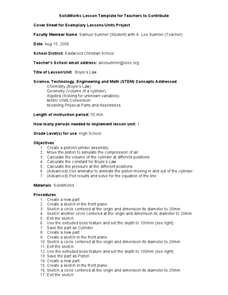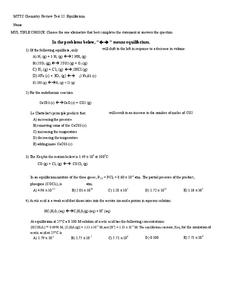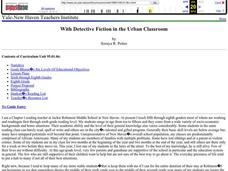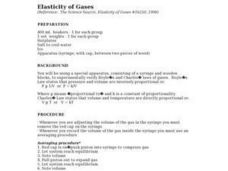Curated OER
Boyle's Law
Students create a piston/cylinder assembly using SolidWorks. In this technology lesson, students calculate volume, pressure and Boyle's law constant. They simulate equalizing air pressure by moving the piston out of the cylinder.
Curated OER
Gases and Chemical Reactions
In this chemical reactions worksheet, students calculate the volume or pressure for different gases. Students determine the effect of different stimuli on the rate of a chemical reaction. This worksheet has 1 short answer, 10 fill in the...
Curated OER
Thermodynamics Homework Problem Set
In this chemistry worksheet, students determine the equilibrium pressure of NO at each temperature listed. Then they explain why lowering the combustion temperature would have any effect on the NO emission. Students also use the values...
Curated OER
Lesson 5: Boyle's Law
Students participate in a lab to verify Boyle's Law using applied force (weight) to do work on a closed isolated system of air. "Elasticity of Gases Apparatus, BASIX" from Sargent-Welch is the syringe apparatus used to measure volume...
Curated OER
Equilibrium
In this equilibrium instructional activity, students predict the concentrations of solutions at equilibrium and apply Le Chatelier's principle to systems at equilibrium. This instructional activity has 15 multiple choice questions.
Curated OER
Problem Solving: Metric Conversion
Using a table, students solve 12 word problems about the weights of various foods at the grocery store. The solve addition and subtraction problems as well as convert kilograms to grams.
Curated OER
Learning Lesson: How it is Currently Done
Students create their own ocean currents by using everyday items. They examine the constant pushing of molecules that makes us feel wind. They discuss how the water moves in the Southern Hemisphere.
Curated OER
Gas Laws
Eighth graders use lab work and software to collect and analyze pressure and temperature data in order to illustrate the relationship between the temperature and pressure of a gas at a constant volume. They conduct a lab and organize...
Curated OER
AP Chemistry-Thermochemistry
In this thermochemistry learning exercise, students answer twenty multiple choice questions about heat, enthalpy changes, thermal, mechanical and electrical energy and the laws of thermodynamics.
Curated OER
Chemistry Lab-Heat of Fusion
Students determine the heat of fusion of ice. In this heat of fusion lesson plan, students use a calorimeter to measure the molar heat of fusion of ice. Students determine the heat required to melt one mole of ice using hot water and ice...
NOAA
Vertebrates II
Mammals of the ocean unite! Or not. The 20th installment of a 23-part NOAA Enrichment in Marine sciences and Oceanography (NEMO) program investigates how warm-blooded marine mammals survive in water. In the class activity, learners use...
Curated OER
With Detective Fiction in the Urban Classroom
This abstract for an instructional unit using three-minute mysteries, stories by Sir Arthur Canon Doyle, and Edgar Allan Poe includes a short history of detective fiction, sample plans, and suggestions for exercises and activities...
Virginia Department of Education
Determining Absolute Age
How can radioactive decay help date old objects? Learners explore half-life and radioactive decay by conducting an experiment using pennies to represent atoms. Young scientists graph data from the experiment to identify radioactive decay...
Cornell University
Chemical Reactions
Investigate the Law of Conservation of Mass through a lab exploration. Individuals combine materials to initiate chemical reactions. They monitor for signs of reactions and measure the masses before and after the reactions for comparison.
Curated OER
Is It There?
Young scholars participate in a lesson designed to illustrate these concepts using simple materials. They use Science process skills to observe, measure, predict, make inferences, and communicate while completing the activity. Proper...
Curated OER
Measuring Temperature and the Production of CO2 in Yeast
Students use a model experiment to complete an experiment on yeast. In groups, they identify the independent and dependent variables and use the scientific method to complete the activity. They record their observations and discuss them...
Curated OER
Packed Trains Can Be Sickening Experience
In this editing worksheet, 5th graders read, analyze and proofread a piece of text for punctuation mistakes. Students read "Packed Trains Can Be Sickening Experience" and correct each punctuation mistake they find.
Curated OER
Avalanches--Beautiful and Awe Inspiring
Avalanche lesson plans can help students learn about this interesting natural phenomena.
Curated OER
Equilibrium Problems
In this equilibrium worksheet, students determine what effect a catalyst has on the rate of a reaction and the activation energy. Students explore how the equilibrium shifts when different stresses are added to a compound. This worksheet...
Curated OER
Fourth Grade Science Quiz
In this science instructional activity, 4th graders take a multiple choice quiz about the weather, moon, electricity, and more. Students complete 15 questions total.
Curated OER
Elasticity of Gases
Young scholars investigate gas laws and apply them in experimental conditions. Using an apparatus composed of a syringe and wooden blocks, they experimentally verify Boyle's and Charles' laws of gases.






















